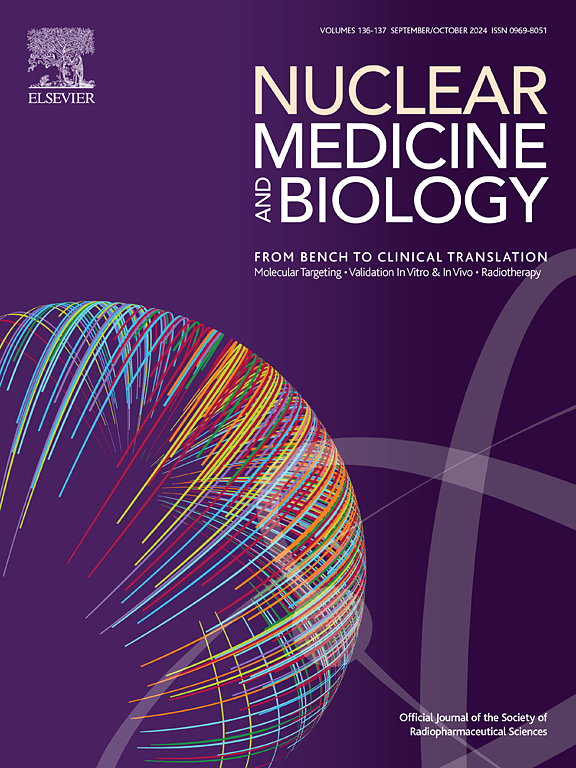Radiation dosimetry of the 18 kDa translocator protein ligand [18F]PBR111 in humans
IF 3.6
4区 医学
Q1 RADIOLOGY, NUCLEAR MEDICINE & MEDICAL IMAGING
引用次数: 0
Abstract
Purpose
The 18 kDa translocator protein (TSPO) is a mitochondrial protein that becomes overexpressed during neuroinflammatory conditions, such as in Alzheimer's disease or multiple sclerosis. TSPO is of interest because it serves as a marker for microglial and astrocytic activity, measurable via in vivo positron emission tomography (PET) molecular imaging. [18F]PBR111 is a second-generation TSPO PET radioligand with high signal specificity but a sensitivity to TSPO polymorphism, in comparison with first-generation ligands. This study focused on the biodistribution and dosimetry of [18F]PBR111 in healthy humans.
Method
Six volunteers (three males, three females) were administered approximately 200 MBq of [18F]PBR111. Organs such as the lungs and liver showed the highest initial radioactivity level, while the bone marrow and bladder accumulated activity over time, likely reflecting ligand defluorination and elimination.
Results
Dosimetry findings revealed a total effective dose of 16.17 μSv/MBq, equivalent to 3.04 mSv per examination. Compared to animal models, human dosimetry showed lower radiation exposure, highlighting discrepancies in predictive models. Organ-specific dose comparisons with other TSPO ligands ([18F]PBR06, [18F]FEPPA, [18F]FEDAA1106) revealed similar distribution patterns. This study underscores the clinical viability of [18F]PBR111 for TSPO imaging, providing critical data for optimizing its safe use in research and clinical settings.
Conclusion
The findings support its potential for studying neuroinflammatory and systemic diseases. The trial registration number is NCT06398392.

人类18kda转运蛋白配体[18F]PBR111的辐射剂量测定
目的:18kda转运蛋白(TSPO)是一种线粒体蛋白,在神经炎症条件下过度表达,如阿尔茨海默病或多发性硬化症。TSPO之所以引起人们的兴趣,是因为它可以作为小胶质细胞和星形细胞活动的标记物,通过体内正电子发射断层扫描(PET)分子成像来测量。[18F]PBR111是第二代TSPO PET放射配体,与第一代配体相比,具有高信号特异性,但对TSPO多态性敏感。本研究主要研究[18F]PBR111在健康人体内的生物分布和剂量学。方法6名志愿者(男3名,女3名)被注射约200 MBq [18F]PBR111。肺和肝脏等器官显示出最高的初始放射性水平,而骨髓和膀胱随着时间的推移积累了活动,可能反映了配体的去氟化和消除。结果总有效剂量为16.17 μSv/MBq,相当于3.04 mSv /次。与动物模型相比,人体剂量学显示较低的辐射暴露,突出了预测模型的差异。与其他TSPO配体([18F]PBR06, [18F]FEPPA, [18F]FEDAA1106)的器官特异性剂量比较显示出类似的分布模式。本研究强调了[18F]PBR111用于TSPO成像的临床可行性,为优化其在研究和临床环境中的安全使用提供了关键数据。结论本研究结果支持其在神经炎症和全身性疾病研究中的潜力。试验注册号为NCT06398392。
本文章由计算机程序翻译,如有差异,请以英文原文为准。
求助全文
约1分钟内获得全文
求助全文
来源期刊

Nuclear medicine and biology
医学-核医学
CiteScore
6.00
自引率
9.70%
发文量
479
审稿时长
51 days
期刊介绍:
Nuclear Medicine and Biology publishes original research addressing all aspects of radiopharmaceutical science: synthesis, in vitro and ex vivo studies, in vivo biodistribution by dissection or imaging, radiopharmacology, radiopharmacy, and translational clinical studies of new targeted radiotracers. The importance of the target to an unmet clinical need should be the first consideration. If the synthesis of a new radiopharmaceutical is submitted without in vitro or in vivo data, then the uniqueness of the chemistry must be emphasized.
These multidisciplinary studies should validate the mechanism of localization whether the probe is based on binding to a receptor, enzyme, tumor antigen, or another well-defined target. The studies should be aimed at evaluating how the chemical and radiopharmaceutical properties affect pharmacokinetics, pharmacodynamics, or therapeutic efficacy. Ideally, the study would address the sensitivity of the probe to changes in disease or treatment, although studies validating mechanism alone are acceptable. Radiopharmacy practice, addressing the issues of preparation, automation, quality control, dispensing, and regulations applicable to qualification and administration of radiopharmaceuticals to humans, is an important aspect of the developmental process, but only if the study has a significant impact on the field.
Contributions on the subject of therapeutic radiopharmaceuticals also are appropriate provided that the specificity of labeled compound localization and therapeutic effect have been addressed.
 求助内容:
求助内容: 应助结果提醒方式:
应助结果提醒方式:


